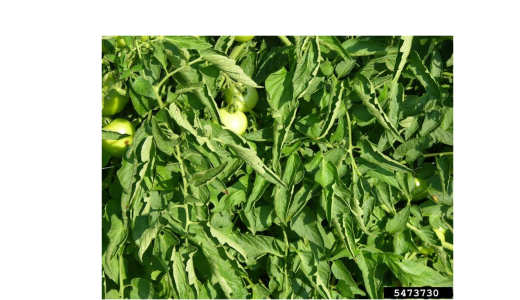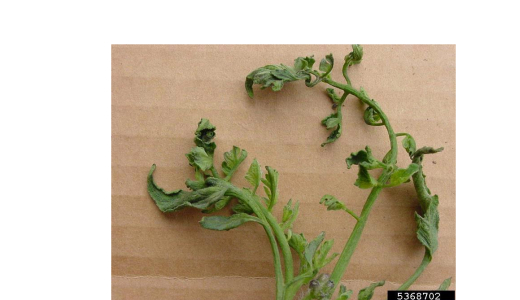
What Causes Tomato Leaves to Curl?
Tomatoes are one of the most beloved cultivated vegetables in home gardens, and whether you grow them often, or are just starting out, one of your possible questions during the growing season might be "Why are my tomato leaves curling?"
There are various factors that can cause curling or rolling of tomato leaves. These factors can be environmental stresses, fungal, bacterial, or viral infections, insects, herbicide damage, overfertilizing, and excess or insufficient water. These factors trigger physiological problems that manifest this condition. It is necessary to take a closer look at your plants to identify which of these factors could be the culprit. You need to see which leaves are rolling (new leaves, old leaves, or all the leaves). What direction do the leaves roll (upward or downward)? Are any other parts of the plant, including fruit, presenting any symptoms?
 Physiological leaf roll of tomato (Photo: Don Ferrin, Louisiana State University Agricultural Center, Bugwood.org) |
1. Physiological
Environmental stress is one of the most common reasons for tomato leaves to curl. Excessive moisture and nitrogen, insufficient phosphorus, heat, drought, severe pruning, root damage from tilling or hoeing, early planting, and transplant shock are some of the cultural and environmental factors that can cause physiological leaf roll in tomatoes.
If tomato leaves are curling due to environmental factors, usually the older leaves will show signs first. Leaves will bend upward and leaflets will curl inward. Leaflets may look thick and leathery. Indeterminate growth varieties tend to present physiological leaf roll more often than determinate varieties.
 |
2. Pathogens
Fungi:
Certain soil-borne fungi can cause tomato leaves to wilt and curl. Fusarium and Verticillium wilts are examples of fungi that enter the roots of your plants, invade the vascular tissue, and consequently limit the nutrient and water transport within the plant. This results in the leaves rolling, wilting, yellowing, and eventually dying.
Remove infected plants (including roots) from your garden and disinfect tools and equipment. Incorporate crop rotation and select resistant cultivars to prevent these diseases in the future.
Bacteria:
Bacterial canker, caused by Clavibacter michiganensis pv. michiganensis, is another important disease that can cause wilting and drooping of tomato leaves. Symptoms on the lower leaves are more pronounced and work their way upwards through the plant, with leaves eventually turning brown and dying. This disease is often introduced by seeds or transplants.
Remove infected plants, and disinfect pots, tools, and equipment to avoid spreading the disease. Plant certified, disease-free plant materials. Incorporate a 3-year crop rotation to avoid this disease in the future.
Viruses:
Some viral infections can also cause leaf curling in tomatoes. The most common viruses in Montana are tobacco mosaic virus (TMV), tomato spotted wilt virus (TSWV), and cucumber mosaic virus (CMV).
Tobacco mosaic virus is a very persistent virus and can be spread by seeds, infected plant sap during cultivation practices, and tobacco products. Infected leaves may show curling, mosaic patterns, deformation, yellowing, and stunting.
Tomato spotted wilt virus is transmitted by thrips and may cause leaves to cup downward. Bronzing and necrotic spots are also common symptoms.
Cucumber mosaic virus is transmitted by aphids. Mosaic patterns and lighter coloring of leaves, leaf curling, and stunting are common symptoms of this virus disease.
There is no treatment for virus-infected plants. Starting with certified, disease-free plant materials and eliminating weeds and insect vectors may reduce the incidence of these diseases. Removal and destruction of plants is recommended. Disinfection of all tools, such as pruners, that were used on diseased plants is critical.
 |
3. Insects
Heavy feeding by piercing-sucking insects such as aphids may cause the leaves to curl, as the insects suck plant juices out of the leaves. Look on the undersides of the leaves to find the insects, and use appropriate control measures.
Many natural enemies (such as predators and parasitoids) help control pests such as aphids in your garden, so utilize integrated pest management (IPM) strategies to minimize the negative impacts to these beneficial insects.
 |
4. Herbicide damage
Another reason for curling tomato leaves is herbicide drift or contamination of topsoil, manure, or compost by herbicide residues. When tomato plants are exposed to the growth regulator herbicides such as 2,4-D, dicamba, aminopyralid, or picloram, typical symptoms include the curling and cupping leaves and twisted growth. These herbicides cause symptoms on the newest growth first. Always follow label instructions when spraying an herbicide, and conduct a bioassay if you are bringing in new soil, compost or manure (see resources below for more information on this).
 |
Herbicide damage on a tomato plant (Photo: Paul Bachi, University of Kentucky Research and Education Center, Bugwood.org)
Herbicide injury cannot be reversed, but if the plant is not killed, it may begin to grow more normally. If tomato plants are subjected to a high dose of herbicide, then they may never recover and should be discarded. If plants are showing symptoms from an unknown herbicide do not consume the produce.
 |
- Choosing determinate growing tomato cultivars.
- Properly hardening off tomato seedlings before planting them in the garden.
- Transplanting tomatoes once the weather has warmed sufficiently.
- Maintaining a consistent moisture level in the soil by mulching around the plants.
- Avoid over-watering.
- Avoid over-fertilization with nitrogen.
- Applying sufficient phosphorus as recommended by a recent soil test report.
- Avoid excessive plant pruning or root damage during cultivation by tilling or hoeing.
- Locate tomato plants in the garden where they will receive late afternoon shade, which is the hottest time of day.
 |
If you have additional questions, please contact your local Extension Office for more information. Your extension agents can assist you in determining the issues with your plants and diagnosing the possible causes, so you can get back to enjoying the fruits of your labor.
By: Francisco Gamboa Herrera (Rosebud and Treasure Counties Agriculture and 4-H Extension Agent), Abiya (Abi) Saeed (Extension Horticulture Specialist), and Dr. Eva Grimme (Plant Disease Diagnostician)